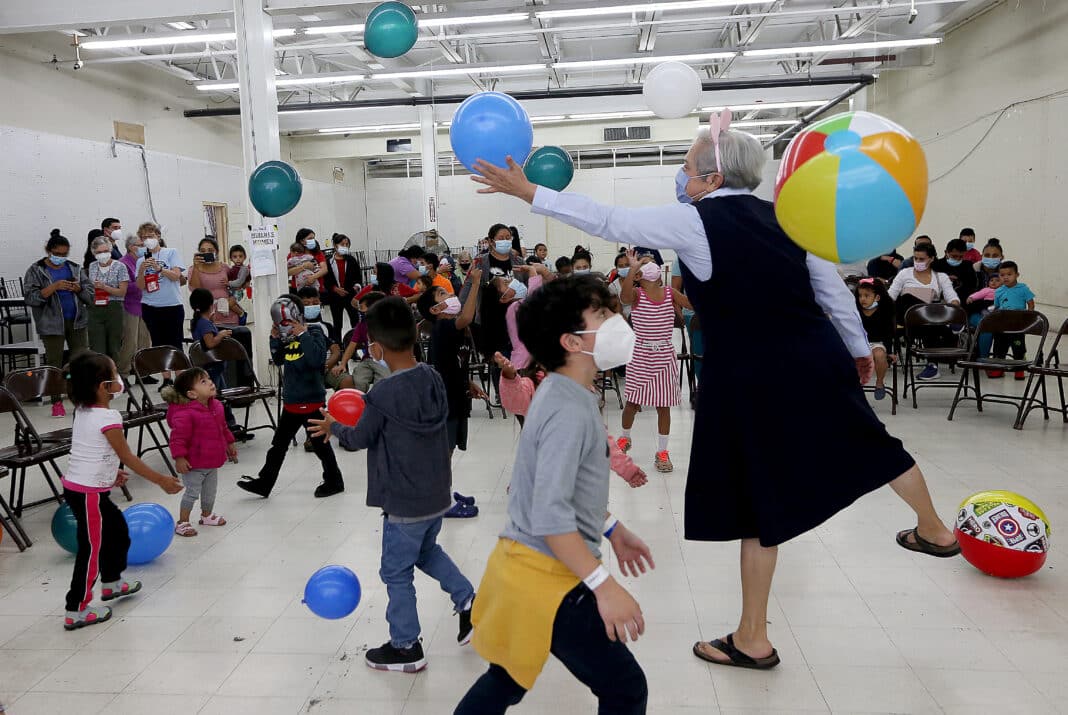Festive music and brightly-colored balloons bouncing above a crowd of dancing migrant children filled a large room inside Catholic Charities of the Rio Grande Valley’s respite center in McAllen Friday afternoon. Families celebrated the Mexican holiday known as Dia del Niño, or Day of the Children, at the end of April, just as the White House announced a drastic reduction in the number of migrant children in CBP custody.
Yeiri Figueroa, a 26 year-old Honduran mother, sat and watched her child play inside the open space encircled by chairs. Two days ago, she was sitting on a plane getting ready to depart to the El Paso/Ciudad Juarez border where U.S. Customs and Border Protection then send her back to Mexico.
Many of the migrants requesting asylum are expelled from the U.S. through a Trump-era CDC directive still in effect under the Biden Administration. Some are released into the U.S. in the Rio Grande Valley and other parts of the country where expulsion to Mexico is not an option, due to logistical issues.
Figueroa entered the U.S. through Reynosa on Monday hoping to be released into the U.S. Instead, she, her son and other mothers with children too young to walk were placed in a bus and taken to El Paso. This was the second time in recent weeks CBP would send her back to Mexico. But the plane would leave without her.
“I got away by God’s divine plan,” Figueroa said.
As she prepared to board Wednesday morning, a federal officer performed a visual inspection of her child’s head and noticed some early signs of chickenpox. It was enough to keep her from flying and sending her away to be released into the U.S.
“Only God knows our needs,” Figueroa said, as she watched her six year old boy play in costume with other kids tossing balloons, making crafts and dancing with Sister Norma Pimentel.
Glittering pink mouse ears sat on Pimentel’s head as she swayed with the music and played with the children fortunate enough to be closer to their dream on Dia del Niño.
“I find a great joy to be able to share opportunities where we can celebrate them,” Pimentel, the respite center’s executive director, said. Divine intervention, she believed, helped them.
“We were like, ‘Do we have enough juices?’ ‘No, we don’t,’” Pimentel recalled. “All of a sudden, another batch of juices arrived. So, it’s amazing how God works marvelously in bringing it together and making it happen.”
In the last three days, Pimentel started noticing fewer migrants released to Rio Grande Valley shelters. About 300 were at the shelter Friday, up from 200 the day before. In the last couple of months since late January, apprehensions and releases in the Valley were so great, migrants were released en masse without immigration court dates and to other churches set up as influx shelters near McAllen.
“Border Patrol is not releasing all of them. They’re returning some of the families back to Mexico,” Pimentel said.
Migrants, like Figueroa, are sent from the Rio Grande Valley Border Patrol sector, which is still overcrowded, to Laredo, El Paso and San Diego where agents have smaller crowds to process.
“Several Border Patrol Sectors have seen an increase in encounters. In order to process individuals as safely and expeditiously as possible, other sectors along the southwest border are assisting by processing these subjects at their facilities,” a statement from CBP read.
The number of migrant children in CBP custody also decreased by 84% from last month, according to a CNN report cited by the White House on Friday.
“The change is largely due to the Department of Health and Human Services’ ongoing efforts to open temporary shelters across the country to house minors while the Office of Refugee Resettlement attempts to connect them with family or sponsors in the U.S.,” the White House statement read.
HHS opened multiple sites to process the unaccompanied children entering their custody, but it does not affect the number of children who enter the country with their parents.
Many end up in places like Reynosa where an encampment, similar to the now-disassembled one in Matamoros, is growing. Families with children six years old and younger are not sent back to Tamaulipas where CBP officials have said shelters are not accepting them. Some are sent to Juarez or Tijuana.
But children older than six years old and their parents roam around a Reynosa plaza near the international bridge — a place ripe for extortion and kidnapping.
“It really concerns us the fact that families in Reynosa are getting stuck there,” Pimentel said.
“The head of immigration of Mexico called me to make sure I can be there and take the lead in working with the different entities that are trying to do something,” Pimentel said.
She is expected to coordinate humanitarian efforts between the churches, local authorities and nongovernmental organizations like Sidewalk School and Angry Tias & Abuelas, which are providing food, rent, and legal services to some of the migrants.
Pimentel looks forward to “Being able to provide them with the options of what they can do, whether they’re going back home, whether they’re going to integrate into the state of Mexico, and what are their plans.”
Children at the respite center continued the celebration Friday by eating smiley-face cookies, slices of vanilla and chocolate cake, and a meal provided by generous volunteers.
Figueroa sat watching her son, recalling their journey, their sacrifices and their suffering. The following day they will leave the Valley and go north where they plan to seek asylum in the U.S. While it’s not a guaranteed promise, one thing is certain, Figueroa said: “Wherever we are, I won’t leave him alone.”




